Élisabeth Vigée Le Brun, Portrait Painter Extraordinaire
Art knows no boundaries, it is said. But before the mass media that arrived in the late 19th century, art in the main was a very upper class affair. And art itself became highly formalised in turn. The strictures that the early surrealists and dadaists rebelled against were at their height at the end of the 18th century, but it was into this world that a most unlikely artistic rebel came along. Élisabeth Vigée Le Brun was an ardent royalist and a conservative at heart, but she elevated portrait painting (considered the most lowly of art forms) to new heights, and broke some pointless taboos while she was at it.
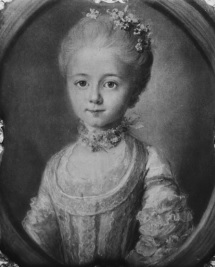
Élisabeth Vigée was born in Paris in 1755. Her father Louis was a portrait artist, working mostly in pastels (though sometimes in oils). He was born a peasant, but through his skills as a painter he rose to the upper middle class that were beginning to become a serious factor in Parisian affairs. Her mother Jeanne worked as a hairdresser, and Élisabeth was her first child. She was followed three years later by a boy, who they named Étienne. Young Élisabeth idolised her father, and it may have been this that first inspired her passion for art. From an early age she drew and painted, and her doting father declared her a born painter. For the first six years of her life Élisabeth mostly lived with relatives in the countryside, and when she was six she went to stay in a convent school in Paris. When she was 11 she returned to Paris, where her father taught her to paint. He was an active member of the Académie de Saint-Luc, a painter’s guild that mostly catered to those who lacked the money or rich patrons to be members of the Académie Royale. [1] He held painter’s salons, where his young daughter’s budding skills were demonstrated to admiring friends. Sadly though this brief golden period in Élisabeth’s life came to an end only a year later. Her father choked on a fishbone, and though a friend managed to remove it the inside of his throat was wounded. The wound became infected and Louis died two months later.
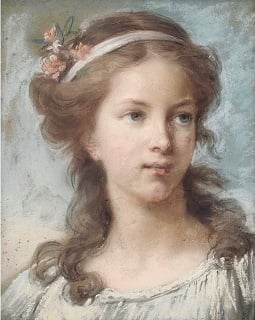
Jeanne remarried the following year to a jeweler named Jacques-François Le Sèvre, who Élisabeth cordially hated. His money did mean that the family were kept off the streets, but as the teenage Élisabeth began to sell her paintings she became convinced that her step-father was hoarding the money she earned to keep her dependent. She didn’t really have much avenue for complaint though – as she was not a member of a guild, it was illegal for her to paint professionally. She got around this by selling and exhibiting the paintings as her father’s unfinished works that she had merely touched up, and to this day there are works that are disputed between the two of them. In the meantime she toiled in the workshops of her father’s friends, learning and honing her techniques.

Female painters were far from uncommon at the time, but they did face some restrictions on their work. Most notably, they were not permitted to attend life drawing classes and learn to paint nudes, as this was obviously considered extremely unladylike. This made it far more difficult for them to draw the traditional “historical” pieces that were considered the most artistic by the highly regimented art world. Portrait painting was considered one of the lowest forms of painting, but like her father it was one that Élisabeth made her speciality. It might have been a tip off by a rival resentful of her growing reputation that led to Élisabeth’s studio being raided in 1774, and her being fined for operating without a license. As a result she applied to the Académie de Saint-Luc. It’s rumored that the reason she was accepted was that they realised they had already unwittingly featured her paintings in their salon. Whether it was that or her undeniable talent that got her in, she was in. At 19 years old, Élisabeth Vigée was now a professional painter.
In 1776 Élisabeth married Jean Baptiste Pierre Le Brun, a 28 year old art dealer. Jean came from a painting family, but his father’s death seven years earlier had forced him to give up his own career and take over the family business. It was a marriage of convenience, rather than a love match. Marriage gave Élisabeth independence, and got her away from her hated stepfather. It also gave her the one thing in her life that she may have loved more than painting – her daughter Julie. She was born in 1780 under the uncomfortable hybrid of Jeanne-Julie-Louise, but to everyone she was always just Julie. By the time she was born her mother was already on the road to becoming one of the most famous painters of her era.
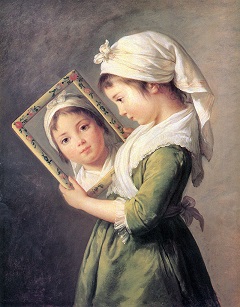
Though being a woman painter had disadvantages, and being a portrait artist was considered low class, it was exactly these traits that Élisabeth would use to ensure her success. After Julie’s birth, Élisabeth and Jean had gone on a trip to the Netherlands. There Élisabeth had done some portraits of nobles, and had been hugely impressed (and influenced) by the works of the Dutch masters. They also confirmed for her that painting portraits was not just “commercial work” – it could be a true calling. She was a master not only of painting, but of setting her clients at ease. She got many female clients, and that was where her skill of gilding lilies came into play. Élisabeth had realised that people did not come to her for a realistic portrayal of themselves, they came to her for how they wished they could be. Her portraits were unmistakably of her clients; but they all were also beautiful. And they made her clients feel beautiful. Élisabeth was selling more than portraits, she was selling them a dream. And people were eager to buy.
The centerpiece of Parisian social life among the middle and upper classes were the salons – social gatherings to share inspiring conversation and appreciate poetry and art. Élisabeth hosted her own salons, and it was at these that her younger brother Étienne gained a reputation as a wit. For Élisabeth though, the salons were all about hunting for customers and building her reputation. That reputation continued to grow, and it finally paid off in a big way. Élisabeth Vigee Le Brun was invited to the Palace of Versailles where she was asked to paint the portrait of France’s controversial queen, Marie Antoinette.
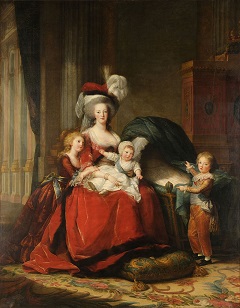
The real problem with Marie Antoinette, in the eyes of the French people, was that she was Austrian. All the actual facts about her withered in the face of her being a member of the royal family of one of France’s greatest enemies. Almost everyone in France had lost a family member in a war against Austria, and those wounds ran deeper than her marriage to Louis XVI could heal. In truth, she was no more nor no less of a monster than any other aristocrat (which may have been part of the problem). But she was well aware that she had an image problem. Élisabeth’s job, therefore, was to humanise the queen. To make her real and sympathetic to the public. It was probably an insurmountable task, but her first portrait pleased the queen enough to make her an official court painter. It was success on a scale that Élisabeth could barely have hoped for.
In France at the time, the royal favour was enough to open even the most stubborn of doors. The premier artistic institute in France at the time was the Académie royale de peinture et de sculpture. It was a deeply classist institution, of course, and the wife of a mere “tradesman” like Jean would never have normally been accepted there. Unless, of course, she had the support of the Queen of France behind her. In 1783 Élisabeth submitted her works for acceptance into the academy, including one rare non-portrait. It was an allegorical piece showing Peace embracing France and presenting her with a cornucopia. After a brief period where the more conservative members of the academy tried to resist her induction, the weight of royal prerogative won the day and Élisabeth was accepted.
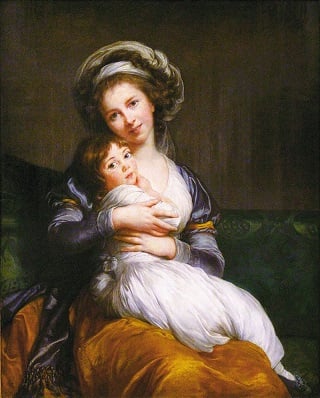
In 1787 Élisabeth’s career was hit by a scandal that could only have happened in the rigidly structured world of French art. She exhibited a self portrait of herself with her daughter but, scandal of scandals, in Élisabeth’s smile her teeth were clearly visible! The French art world was shocked at this. Such a thing might be permissible in lax Dutch art but, as one magazine put it, it “finds no precedent among the Ancients”. It was a small act of rebellion against the establishment; perhaps one carefully calculated to make Élisabeth more appealing to the bohemian set. Little did she suspect that her entire world was about to turn out to be perched on a precipice.
Like most people, the rapid progression of events in France during 1789 caught Élisabeth by surprise. Though she had been replaced as Marie Antoinette’s court painter, she was smart enough to realise that her association with the royal family made her unsafe. After they were arrested, she took Julie and fled the country. Her husband Jean was left behind, and in fact the strict laws against emigres (those who had escaped “revolutionary justice”) meant that he had to divorce her in order to avoid having all of his property seized on her account (and possibly also losing his life). Élisabeth herself was left with nothing except her daughter and her talents. But really, that was all she needed.
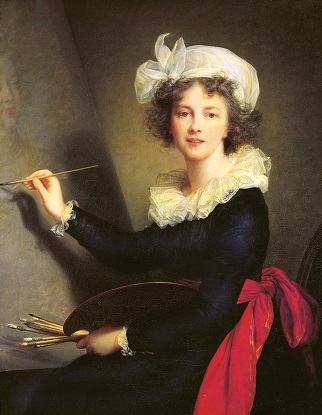
Élisabeth was welcomed into Italy, and was feted and celebrated by the artistic community. In Bologna she was made an honorary member of the city’s artist’s academy. And in Florence the famous Uffizi Gallery [2] asked her to contribute to their collection of artist’s self-portraits. She produced a painting that has been described as a masterclass in self-promotion. The portrait shows her apparently caught in the middle of a painting session, with her palette and brushes in her hands. Her subject is her old patron Marie Antoinette, firmly nailing her Royalist colours to the mast. Élisabeth herself is dressed fashionably and painted attractively, looking directly at the viewer. And, of course, her mouth is open slightly, and her flawless white teeth are visible.
From Florence Élisabeth went to Rome, where she spent eight months as the toast of the town before moving on to Naples. There she was commissioned to paint the royal family, and several other prominent locals as well. One of the most notable of these was Emma Hamilton, the famous English beauty (and mistress of Lord Nelson). Her husband was the British Ambassador to Naples at the time. After six months in Naples, Élisabeth went on a general tour around Italy over the next few months. She had hoped that things back home would have calmed down and that she could return to France at that point, but of course that was far from the case. So she set her sights north, and settled in Vienna.

Vienna was as welcoming to Élisabeth as Italy had been, and there was no shortage of work or company. But it was while she was in the city that Louis XVI was executed in Paris. Shortly thereafter the Revolutionary Tribunal was established in Paris, and the Terror began. So it was that Élisabeth’s time in Vienna, though far from unpleasant, was always haunted by the news of another friend or former client’s death at the hands of “Madame la Guillotine”. Late in 1793 word reached her that her old friend and patron Marie Antoinette had been executed. Of course, as an emigre Élisabeth herself would have automatically faced the same fate if she fell into the regime’s hands. It was only the death of Robespierre and his cabal in July of 1794 that ended the parade of executions.
In 1795 Élisabeth moved to Russia, where her skill and reputation soon gained the notice of the imperial court. This was the most prolific period of her career, as Russian noblewomen were lining up around the block to have her paint their portrait. Even the Empress, Catherine the Great, came to her. She commissioned Élisabeth to paint her favourite granddaughters Alexandra and Elena. The result (and Élisabeth’s willingness to amend the painting when Catherine had a quibble with it) impressed her. The empress herself then asked Élisabeth to paint her, but sadly Catherine died of a stroke before she was due to sit for it.
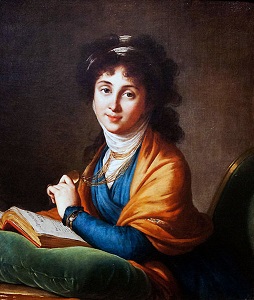
Élisabeth’s time in Russia was mostly a joy, but there was one major fly in the ointment. And the name of that fly was Gaëtan-Bernard Nigris. He was the secretary to a count named Ivan Chernyshyov, and he was also the man that Julie Le Brun had decided she was in love with. Élisabeth’s beloved daughter had grown up into a headstrong teenager, and Élisabeth was now paying for the indulgence she had always shown her daughter. Despite her mother’s insistence that Gaëtan was only after their money, Julie was determined to marry him. In 1799 the 18 year old Julie did marry him, and Élisabeth cut her off. Though the marriage proved to be short-lived (which probably showed that Élisabeth had been right about Gaëtan) Julie blamed her mother’s lack of support for blighting her marriage. The two women would be estranged for several years, something which wounded Élisabeth deeply.
Upset by her daughter’s marriage, Élisabeth decided to leave St Petersburg and moved to Moscow, Russia’s second city at the time. After some time there she moved to Berlin, where word reached her that her husband and her friends in Paris had finally succeeded in having her name removed from the list of emigres. In January of 1802 she finally returned to her home city. There her ex-husband did all he could to show his contrition for having divorced her, and the pair were reconciled. Élisabeth still found it hard to settle though, and made several long visits to England. It was during one of these, in 1804, that word reached her that Julie had come back to Paris. Élisabeth immediately returned and the pair were reunited, though their relationship was never as close as it had been.
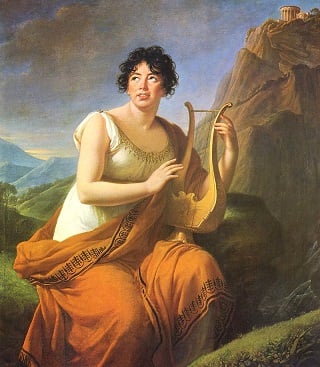
In 1808 Élisabeth made her last major trip, to Switzerland. By this time she had mostly retired from painting portraits and was beginning to concentrate on landscapes. She did make a painting of her hostess though, the renowned anti-establishment intellectual Germaine de Stael. In 1813 her husband Jean died. Though the two had never been close, she was genuinely upset at his death. This was nothing though compared to the grief she felt six years later when Julie died, aged only 38 years old. The following year Élisabeth’s brother Étienne also passed away, leaving her even more alone.
Élisabeth spent the last twenty years of her life in Paris. She refused to become a recluse, and her two nieces (one the daughter of Étienne, the other a daughter of Jean’s brother) supported her as she grew older. Madame Le Brun’s salons remained a staple of the Parisian artistic social scene, and she was exhibited in the Academy’s Salon in 1824. She published her memoirs in 1835, offering people a window into a pre-Revolutionary world that must have felt a lifetime away. It was. In 1842 she suffered a stroke, and by the end of the year she had passed away. She left behind a vast body of work spread across the world, documenting some of the most famous names in history as well as many people who nobody would remember but for her painting. She showed us the faces of history – and she made them beautiful.
Images via wikimedia except where stated.
[1] Though of the two, the Académie de Saint-Luc was by far the more established – it was over 250 years older than the Académie Royale.
[2] Which would one day recover the lost Mona Lisa.
